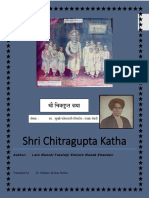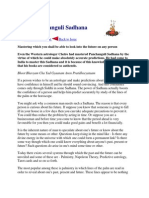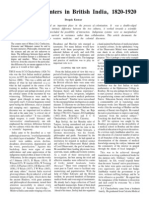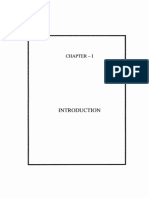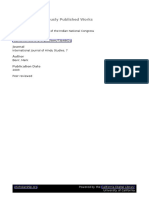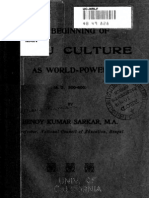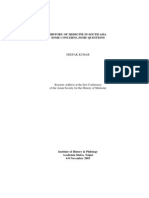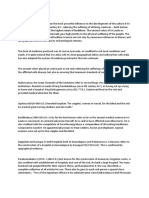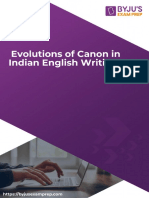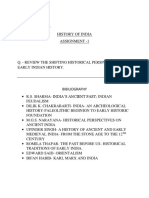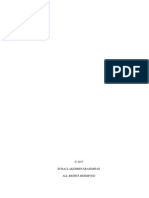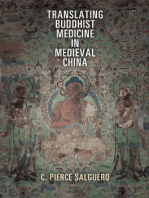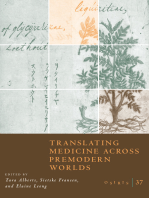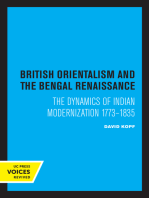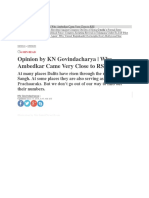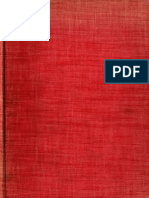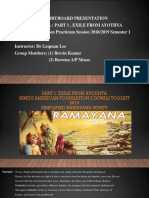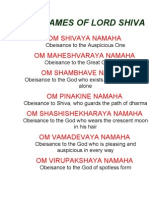Uma Ganeshan
Uma Ganeshan
Uploaded by
Talha WaheedCopyright:
Available Formats
Uma Ganeshan
Uma Ganeshan
Uploaded by
Talha WaheedOriginal Description:
Copyright
Available Formats
Share this document
Did you find this document useful?
Is this content inappropriate?
Copyright:
Available Formats
Uma Ganeshan
Uma Ganeshan
Uploaded by
Talha WaheedCopyright:
Available Formats
Studies on Asia
Medicine and Modernity: The Ayurvedic Revival Movement in India, 1885-1947
Uma Ganesan University of Cincinnati, OH
This essay analyzes the ayurvedic revival movement of the late nineteenth and early twentieth century as a case study of reform and revival within colonial India. On the one hand, nationalism provided the space or fertile ground for revival of ayurveda. On the other hand, the demand for swaraj or home rule, which increased in frequency and intensity during the 1920s and 1930s, also entailed the projection of a modern, scientific, and progressive image of India in order to justify and legitimate that very demand. Therefore, efforts to revive ayurveda during this period placed importance on establishing its scientific and progressive credentials. An analysis of the revivalist discourse can help to unravel the important connections among nationalism, identity, modernity, science, and medicine during these crucial decades of the twentieth century. By the end of the nineteenth century, ayurveda along with other indigenous systems of medicine such as unani (Graeco-Arabic medicine)1 and siddha (South Indian Tamil traditional medicine ) 2 were profoundly influenced by their encounters with Western medicine. The closing decades of the nineteenth century witnessed a proliferation of books on ayurveda in English, Sanskrit, and vernacular languages as the proponents of ayurveda tried to transform the hitherto relatively inaccessible knowledge into social
1 Guy N. A. Attewell. Refiguring Unani Tibb: Plural Healing in Late Colonial India. Hyderabad, India: Orient Longman, 2007.; Seema Alavi. Islam and Healing: Loss and Recovery of an Indo-Muslim Medical Tradition, 1600-1900. New York: Palgrave Macmillan, 2008. 2. Richard S. Weiss. Recipes for Immortality:Medicine, Religion, and Community in South India. New York: Oxford University Press, 2009.
Studies on Asia
knowledge as well as a shared system of knowledge among the practitioners. 3 This outpouring of ayurvedic publications roughly coincided with the rise of nationalism 4 in general and that of Hindu revivalist nationalism 5 in particular. It was also a response to the colonial governments decision in 1835 to suspend the teaching of ayurveda in the Calcutta Medical College. 6 While of crucial significance to this early period, ayurvedic publications addressing the theme of ayurvedic knowledge and history continued to sustain the movement through the first half of the twentieth century. Also, Ayurvedic practitioners organized themselves as a professional interest group through the founding of the All India Ayurvedic Congress (A.I.A.C.) in 1907. The annual conferences organized by the A.I.A.C provided another key forum for revival efforts. The proceedings of these conferences along with books, tracts, and journals provide useful source material for the historian interested in understanding how the proponents of ayurveda positioned themselves and their art within the larger nationalist discourse that envisioned a modern, scientific, progressive future for India. Thus, the focus in this paper is on how a male elite, doctors and vaids (ayurvedic practitioners) in particular, envisioned the medical past, present, and future of India. Three themes were central to the ayurvedic revivalist discourse contained in the literature on ayurveda and the conference proceedings of the A.I.A.C: British Orientalism, the synthesis of medical systems, and institutionalization of ayurveda. These themes were common to multiple reform and revival efforts in colonial India. The latter two themes must be seen as specific manifestations
K.N. Panikkar. Culture, Ideology, Hegemony: Intellectuals and Social Consciousness in Colonial India. London: Anthem Press, 2002, 165.
3
The Indian National Congress, the organization that spearheaded the nationalist movement, was founded in 1885 in Bombay.
4 5
For an account of Hindu revivalist nationalism, see Tanika Sarkar, Hindu Wife, Hindu Nation: Community, Religion, and Cultural Nationalism (Bloomington, IN.: Indiana University Press, 2001) Panikkar, Culture, Ideology, Hegemony, 150-151.
109
Series IV, Volume 1, No. 1, Fall 2010
of the larger theme of Indians attempts to preserve tradition while at the same time appealing to modernity and its corollaries of science, reason, and progress. Hence, as in the other movements, the interplay of these themes in the ayurvedic revival movement generated the kinds of complexities, contradictions, paradoxes, and inconsistencies inherent to any project that attempted to articulate its needs, aspirations, and goals within the terms of the very structure (the western medical system) it was responding to or reacting against. The story of ayurvedic revival brings into focus the tension between structure and agency in a colonial setting: How far did the structure the western colonial system constrain the choices of these reform and revival movements? British Orientalism British Orientalism refers to a set of ideas and practices inaugurated under Warren Hastings, Governor-General of Bengal from 1773 to 1785 that sought to know and understand the languages and culture of India as a key step toward good governance. Deploying eighteenth century Enlightenment ideals, British Orientalists such as William Jones and Henry Thomas Colebrooke translated ancient texts, posited a Vedic golden age of Aryan Hindus, identified Sanskrit as the fount of Indian civilization, and in the process stimulated a vigorous intellectual and cultural renaissance among the Bengali elite. 7 This generally positive attitude to ancient Indian culture coexisted alongside the denigration of contemporary conditions which served to justify the British presence in India. In response to this, early reformers such as Ram Mohan Roy (1772-1833) sought to selectively reform and recast Hindu socio-religious practices while drawing upon the Orientalist discourse of early glory and
David Kopf. British Orientalism and the Bengal Renaissance: The Dynamics of Indian Modernization, 1773-1835. Berkeley: University of California Press, 1969.; Tony Ballantyne. Orientalism and Race: Aryanism in the British Empire. New York: Palgrave, 2002.; Thomas R. Trautmann. Aryans and British India. Berkeley: University of California Press, 1997.; Michael S. Dodson. Orientalism, Empire, and National Culture: India, 1770-1880. New York: Palgrave Macmillan, 2007.
7
110
Studies on Asia
achievement a trend that would characterize several reform and revival movements in colonial India. 8 Aryans, antiquity, Vedic civilization ideas that were at the heart of British Orientalism were invoked in the service of ayurveda. In an early (1895) and widely acknowledged contribution to the ayurvedic revival movement, Bhagvat Sinh Jee, the Maharaja of Gondal (a princely state in western India), Fellow of the Royal College of Physicians of Edinburgh, and later Vice-President of the Indian Medical Association, provided a brief sketch of Hindu achievements in astronomy, mathematics, chemistry, music, religion, philosophy, architecture, lexicography, grammar, and the art of war during a Vedic golden age and argued that All this unmistakably proves that the Aryans were the most enlightened race in the dawn of history.When the state of civilization was so perfect, and when all sorts of useful sciences were regularly studied, there should be no wonder if the science of Medicine too received its share of attention. This Science forms part of the Vedas, and is called Ayur Veda or the Science of Life. 9 Thus, placing ayurveda in the context of achievements in other sciences served to emphasize its normalcy. Similarly, in 1919, Nagendra Nath Sen Gupta, an ayurvedic practitioner from Bengal and a prolific author of books on ayurveda asserted that
See: Kenneth Jones. Arya Dharm: Hindu Consciousness in 19th Century Punjab. Berkeley: University of California Press, 1976.; David Lelyveld. Aligarhs First Generation: Muslim Solidarity in British India. Princeton, N.J.: Princeton University Press, 1977.; Barbara Metcalf, Islamic Revival in British India: Deoband, 1860-1900. Princeton, N.J.: Princeton University Press, 1982.; Harjot Oberoi. The Construction of Religious Boundaries: Culture, Identity, and Diversity in the Sikh Tradition. Chicago, IL.: University of Chicago Press, 1994.
8
Bhagvat Sinh Jee. A Short History of Aryan Medical Science. Gondal: Shree Bhagvat Sinh Jee Electric Printing Press, 1927., First Published in 1895, 2223.
9
111
Series IV, Volume 1, No. 1, Fall 2010
It would be no exaggeration to say that of all nations of the earth, the Hindus first turned their attention to the study of disease and the means of its alleviation. The Vedas are undoubtedly the most ancient of written records in the world. The Ayurveda or Science of Life is believed to have formed a part of the Vedas, vis., those that go by the name of the Atharvas. 10 Indian elites responded to the colonial gaze by articulating an indigenous version of a glorious past of Hindu culture. As Michael Dodson argues, British Orientalism proceeded from being a hand-maiden of Britains fledgling Indian empire to being linked with the emergence of early forms of Indian national identity and anticolonial cultural movements. 11 Ayurveda was one of the Sanskritic Vedic traditions that Indian nationalists, particularly Hindus, drew upon. Thus, for example, D. Chowry Muthu, an Associate of Kings College, London and a consulting physician for the Thambaram Sanatorium in Madras which he had established in 1928, deployed the Orientalist discourse that emphasized a vibrant and strong HinduAryan past: The history of Hindu medicine.takes us back to the very cradle of Aryan civilization.Whether it be in the domain of art or science, in poetry or philosophy, in religion or mythology, in commerce or manufacture, ancient India excelled in almost every department of human activity or enterprise for many, many centuries. 12
Nagendra Nath Sen Gupta. The Ayurvedic System of Medicine or an Exposition, in English, of Hindu Medicine as Occurring in Charaka, Susruta, Bagbhata, and other Authoritative Sanskrit Works, Ancient and Modern, Vol. 1. New Delhi: Logos Press, 1984. First Published in 1919, i.
10
See Introduction: Histories of Empire, Histories of Knowledge, in Dodson, Orientalism, Empire, and National Culture, 1-17.
11 12 D. Chowry Muthu. A Short Account of the Antiquity of Hindu Medicine and Civilization. London: Bailliere, Tindall & Cox, 1930, 5-6.
112
Studies on Asia
Written in 1930, nearly a century after the British abandoned the Orientalist discourse, Muthus account demonstrates the continued power of that discourse in lending credence to identity construction and national consciousness among elites in colonial India. Since ayurvedic proponents argued that Hindu civilization and Hindu medicine could not be separated, this discourse had particular relevance for ayurvedic revival efforts. As the medical history of the Indo-Aryans forms an inseparable part of the history of their civilization, the proof of antiquity of their medicine can be found in the antiquity of their civilization.no nation on earth can vie with the Hindus in the antiquity of their civilisation and religion.the history gathered from the recent rendering of the Vedic hymnstake[s] one back to immemorial antiquity. 13 Ayurveda was the progenitor of medicine whose glowing embers had lighted the torch of Arabian medicine, and through it the fire of European medicine. 14 Shiv Sharma, youngest president of the All India Ayurvedic Congress in 1938 elaborated: The evidence adduced in favor of the indebtedness of the Greeks and Arabs to the Hindus in the science of medicine may also serve to prove that the system of Ayurveda stands unrivalled in its antiquity. The presence of the Ayurvedic principles in the hymns of the Vedas, the earliest records of human intellect, establishes for good the high antiquity and the originality of Hindu Medicine. 15 For Sharma it was only too natural for the ancient Hindus to bring forth a highly developed system of medicine consistent with their
D. Chowry Muthu. A Short Account of the Antiquity of Hindu Medicine and Civilization. London: Bailliere, Tindall & Cox, 1930, 8.
13 14
Ibid, 40.
15 Shiv Sharma. The System of Ayurveda. Delhi: Neeraj Publishing Hoiuse, 1929, 90.
113
Series IV, Volume 1, No. 1, Fall 2010
other scientific achievements. Placing ayurveda in the context of overall early Hindu achievement was important to revivalists attempts to explain contemporary degeneracy in terms of a general decline of Hindu civilization of which ayurveda was but a part. Therefore, the contemporary condition of ayurveda was a manifestation of the larger condition of Indian society, and not inherent deficiencies as a medical science. The Society for the Resuscitation of Indian Literature in Calcutta, a prolific publisher of books on Hindu philosophy, theology, and literature many of them translations of classics, also published one on ayurveda in 1899, further emphasizing the notion that medicine was an integral part of classic Hindu civilization. This was also a reflection of the growing Hindu revivalist nationalism of the late nineteenth century. This book in keeping with the tendency to stress the antiquity of ayurveda as an important first step in making a case for its revival argued that for the first conception of the medical science the whole world is indebted to the Rishis of India 17 and pointed out that [l]ike various other departments of science and literature, the Hindu medical system claims to be the first of its kind in the world and has lent much towards the advancement of the medical systems of other countries. 18 As David Arnold argues, in invoking the past Indians were not merely setting the historical record straight but were also shaping contemporary identities and aspirations. 19 Thus, the apparent paradox of the modern nations return in the archaic was resolved as Hindu intellectuals posited religion as the embodiment of eternal and universal laws.forg[ing] difference into unity, multiplicity into
Shiv Sharma. The System of Ayurveda. Delhi: Neeraj Publishing Hoiuse, 1929, 68.
16 17 The Society for the Resuscitation of Indian Literature, Ayurveda or the Hindu System of Medical Science. Calcutta: H. C. Dass, 1899, 12. 18
16
Ibid, 1.
David Arnold. A Time for Science: Past and Present in the Reconstruction of Hindu Science, 1860-1920 in Invoking the Past: The Uses of History in South Asia, ed. Daud Ali. New Delhi: Oxford University Press, 1999, 157.
19
114
Studies on Asia
singularity. homogenous, whole and pure. 20 Thus, the Orientalist discourse of past glory and contemporary degeneracy was deployed to fashion a new identity in keeping with the goals of modernity, science, and progress a maneuver that typified much reform and revival efforts in colonial India. Like the early reform movements that British Orientalism spawned, the ayurvedic revival movement also reinterpreted and defended Hindu civilization in the light of modern European scientific thought. M. M. Gananath Sen, an ayurvedic practitioner from Bengal who founded both a college for the study of ayurveda and a pharmaceutical concern for manufacturing ayurvedic medicine, pointed out that the charge that Ayurveda is not a progressive system is not so much a charge against the science itself as against ourselves 21 for when the greater part of the world was submerged in the abyss of ignorance, it is the Indian sages who first understood the necessity of dissection of the human body in the education of Physicians and Surgeons. 22 Therefore, science was part of Hindu civilization and ayurveda was not at odds with modernity: If Ayurveda is not scientific, it is not worth pleading for. 23 In a similar vein, Jivaram Kalidas Shastri, ayurvedic practitioner and royal physician of Gondal, posited that To the Aryans, their Healing Art is as old as the Vedas which they regard as of divine revelation. Even those who speak of their human origin do not fail to recognize their antiquity in
Gyan Prakash. The Modern Nations Return in the Archaic, Critical Inquiry, vol. 23, no.3, Spring 1997, 539.
20 21
M.M. Gananath Sen, Hindu Medicine: An Address on Ayurveda Delivered at the Foundation Ceremony of Benares Hindu University in 1916. Calcutta: Kalpataru Palace, 1937, 23. Ibid, 11.
22
Sen. The Scientific Basis of Ayurveda: An Address Delivered before the South Indian Medical Union, Madras (1923), in Lectures of M.M. Gananatha Sen Saraswati. Varanasi: Chowkhamba Sanskrity Series Office, 2002, 2.
23
115
Series IV, Volume 1, No. 1, Fall 2010
the remote past.The might[y] sages of oldshaped Ayurveda as a systematized science. 24 The reference to science and antiquity in the same breath challenged modernitys sole claim to science and also pointed to the contradiction implicit in the British dismissal of ayurveda. The contemporary condition of ayurveda thus could not be used to judge its past glory. If science was the yardstick by which medical knowledge and practice was measured, then ayurveda had the first and most ancient claim to it. This analysis of the revivalist discourse of ayurveda reveals certain key shared features with other reform and revival movements that adopted the British Orientalist discourse of early achievement and subsequent decline of Hindu civilization, central to which was an appeal to an orginary, pure, Vedic/Sanskritic tradition. The Brahmo Samaj, founded in 1832 in Bengal, was an early example of this effort as it posited a monotheistic, philosophical version of Hinduism devoid of rituals and social practices such as caste and sati which were seen as later accretions. Similarly, the Arya Samaj, founded in 1875 in western India, advocated a return to the Vedas as the fount of Hindu civilization and rejection of all later accretions to the Vedas as degenerate. 25 Also, much like the ayurvedic revival movement which attempted to cleanse ayurveda of degeneracies and separate it from what were seen as ignorant and superstitious folk practices 26 the Brahmo Samajists and Arya Samajists privileged Sanskritic textual Brahminic traditions to the detriment of social practices and customs. Therefore, claiming legitimacy for Hinduism and ayurveda involved recovering ancient texts to posit early glory and achievement. This again had its antecedents in British efforts to outlaw Sati when they sought the help of learned Brahmins to interpret the scriptures for them, thus legitimating written texts as the sole criteria for judging
Jivaram Kalidas Shastri. Presidential Address: 31st All India Ayurved Congress, Lahore, December 1942. Gondal, 2nd Edition, 12.
24 25
See Jones, Arya Dharm.
26 David Arnold. Science, Technology and Medicine in Colonial India. Cambridge University Press, 2000, 179.
116
Studies on Asia
the validity of Hindu customs. 27 Thus, Indians countered the British discourse of people with no history by constructing the history of Hindu medicine and civilization central to which was the study of ancient books. Thus, these reform efforts functioned within an upper-caste, upper-class idiom that was Hindu and male. 28 Having set the historical record on Hindu medicine straight and acknowledged the need for reform, how did the revivalists conceive of ayurvedas future? The next two sections will explore this question. Synthesis of Medical Systems As Ayurveda was pushed to a defensive position from which it could not extricate itself completely, its revival, occurring as it did under the glare of western medicine, depended on continuously answering its critics as well as justifying itself in terms set by its critics. G. Srinivasa Murti, Director of the School of Indian Medicine established in Madras in 1924, pointed out that the violent denunciations of ayurveda cannot be relegated to an earlier period for the Ayurvedic movement is even now being treated to them in some scientific quarters. 29 Examples of this included Mr. Pilchers reference to the preposterous Ayurvedic and Younani Systems of Medicine 30 and Surgeon General (of Bombay) Hootons characterization of ayurveda
See Lata Mani. Contentious Traditions: The Debate on Sati in Colonial India, in Recasting Women: Essays in Indian Colonial History, ed. Kumkum Sangari and Sudesh Vaid. New Jersey: Rutgers University Press, 1999, 88-126.
27
For other articulations of the ayurvedic past, present and future, see Kavita Sivaramakrishnan, The Use of the Past in a Public Campaign: Ayurvedic Prachar in the Writings of Bhai Mohan Singh Vaid, in Invoking the Past: The Uses of History in South Asia, ed. Daud Ali. New Delhi: Oxford University Press, 1999, 178-191 and Charu Gupta, Procreation and Pleasure: Writings of a Woman Ayurvedic Practitioner in Colonial North India, Studies in History, vol 21, no.1, February 2005, 17-44.
28 29
G. Srinivasa Murti. Our Aims and Ideals, The Journal of Ayurveda or the Hindu System of Medicine (JAHSM), vol. 1, no. 1, July 1924, 10. Mr. Pilcher & Ayurveda, JAHSM, vol. 4, no. 3, September, 1927
30
117
Series IV, Volume 1, No. 1, Fall 2010
as being based on erroneous theories that cannot bear comparison with the modern system of Medicine founded on recent advances in Science. 31 Stinging reactions to these views were evidence of the continuing need felt by the proponents of ayurveda to defend it in terms of its antiquity and scientific basis. Thus, M. R. Samey, a passionate defender of ayurveda and a harsh critic of British rule, challenging the Surgeons denunciation of ayurveda retorted, The worthy in his Service Throne felt uneasy at the rearing of his Enemys head and chooses to mollycoddle it in his Blue Book. This philippic against [the]Indigenous System of Medicine is naively introduced into the Report by way of precious vituperation to be standardized as a classic monograph and Public Document 32 and What then remains of modern Medicine if our heritage is discarded?....who has given the first system of Medicine to the world? The Hindus Charaka and Sushrata. Egypt, Greece and Rome built their medical systems on these World Classics of Medicine and England only painted it red and claimed it as her own.45 K. P. Sankara Pillai, writing in 1933, declared, The freedom of our dear mother land remains in the resurrection of our ancient civilization and in the utter abolition of modern inventions with their incommodious paraphernalia. Our Rishis have practically shown us that man is completely self-sufficient. Then why not work for the realization of this, rather than follow the delucive meteor of occidental unrest. 33
M. R. Samey, Hooton Hoots out Ayurveda, JAHSM, vol. 4, no. 4, October, 1927, 121.
31
M. R. Samey, Hooton Hoots out Ayurveda, JAHSM, vol. 4, no. 4, October, 1927, 122.
32 33 K.P.Sankara Pillai. Ayurveda and some Western Medical Sciences, JAHSM, vol. 10, no. 4, October, 1933, 221.
118
Studies on Asia
Such a pungently reactionist discourse for the most part coexisted with the recognition of the need for accommodation and cooperation. Murti offered a proposal for cooperation In so far as the one common ideal of all Systems of Medicine is the preservation of health and prevention or cure of illhealth, there can really be but One System of Medicine, of which the many existing systems are but parts, each part being more appropriately looked upon as a special school of thought rather than as an independent System of Medicine. Consistently with this view, one would like to see that the future practitioners of India, no matter whatever denomination they belong to Ayurveda, Unani, Siddha or European Medicine - as so schooled and trained so as to bring to bear on the problems of Health and Ill-health, not only the expert knowledge of their own systems but, as far as practicable, the best that is in other systems also.It is the true ideal of Ayurveda and must not be lost sight of on [any] account. 34 Several motivations, compulsions, and understandings underpinned the move toward cooperation between the two systems of medicine in the noble cause of health and well-being. The recognition that western medicine was here to stay due to its patronage by the colonial government, its appeal as a modern, rational, progressive, research-oriented system, and its value and usefulness in several areas of health and disease together with practical exigencies such as the fact that vaids and hakims remained the main source of medical succor to the millions in rural India prompted many of the ayurvedic proponents to argue for a synthesis. An anonymous article in the JAHSM in 1927 defended provincial governments support of ayurveda in the following manner: It was an outcome of the economic and business point of view of those provincial Governments who have given State-aid to existing Ayurvedic institutions incorporating in their teaching what is lost or unknown to Ayurveda from modern medicine, so that the best of
34
Murti, Our Aims and Ideals, JAHSM, vol. 1, no. 1, July 1924, 10.
119
Series IV, Volume 1, No. 1, Fall 2010
both systems are taught to the students. One of the tools lost to ayurveda, both due to Buddhist abhorrence of it and popular prejudice against it, was surgery. 36 Therefore, its inclusion in the curriculum of Ayurvedic colleges was one way to enable ayurveda to progress and keep up with western medicine. Thus, for example C. G. Mahadeva argued: There cannot be water-tight compartments between the two systems of medicine. Both aim at alleviating human suffering.What is really good in one must be assimilated by the other.Surgeonsshould be invited to take charge of Surgical wards of Hospitals attached to these [Ayurvedic] institutions. These surgeons should have strong ambitions to see that Ayurveda should be a progressive science and that latest surgery must be taught to Ayurvedic practitioners and students as it is taught in the sister institutions teaching Western Medicine. 37 Some proponents engaged in a reasoned analysis of the pros and cons of the different systems of medicine to underscore the imperfections contained in all of them so that synthesis could be understood not as a sign of capitulation but of strength: The real system of medicine should be one, unifying all these different schools and thereby forming a united system in which all the good things of all the schools should be given place, so that this united system may be more perfect than the disjointed individual sciences. 38 These proponents were motivated by a desire to end the acrimony between vaids and doctors:
35
35
Pilcher, JAHSM, 4 (3), September, 1927.
Girindranath Mukhopadhyaya. Ancient Indian Surgery: Surgical Instruments of the Hindus with a Comparative Study of the Surgical Instruments of the Greek, Roman, Arab, and the Modern European Surgeons, vol. 1. New Delhi: Cosmo Publications, 1994.
36 37 C.G. Mahadeva. Necessity of Introducing Western Surgery in Ayurveda, JAHSM, 6 (7), January 1930, 241-242. 38
The Science of Medicine, JAHSM, 8 (5), November, 1930, 164.
120
Studies on Asia
Our object is to put a stop to the habit of throwing stones at each other. It is also our object to request our brother Allopaths to study ayurveda as it is, and incorporate what is good in Ayurveda into their system. We are also trying to remodel Ayurveda in the line of other sciences, purging it of all its defects, if any, and incorporating everything good, found in other allied sciences, into it, even at the sacrifice of the fetish, prestige. 39 M.M. Gananatha Sen, too, while not conceding much to western medicine, acknowledged the importance of cooperation in the common cause of alleviating disease and suffering: An open-hearted and liberal co-operation of both should be a source of great help to the profession as a whole and to the sufferers entrusted to our care. 40 The ayurvedic revival movement, like other reform and revival movements, was not a simple, linear isolated process of reviving a pristine, pre-colonial indigenous system but a complex one of emphasizing tradition while at the same time attending to the changed and changing conditions under colonialism. As Deepak Kumar argues, condemnation and appreciation of western medicine coexisted in a complex relationship. 41 An anonymous article in the June 1928 issue of the JAHSM argued: Medical Education in India should be so devised that it should take into account not only the present-day medical education but also medical knowledge of the past.While Ayurveda cannot move on in [an] old groove, Allopathy should not be accepted in toto for India. While we should absorb the pathology of the seed of disease from
39
Science versus Empiricism, JAHSM, 9 (3), September 1932, 84. Sen. Address at Benares Hindu University, 25.
40
Deepak Kumar. Unequal Contenders, Uneven Ground: Medical Encounters in British India, 1820-1920, in Western Medicine as Contested Knowledge , ed. Andrew Cunningham and Bridie Andrews. New York: Manchester University Press, 1997.
41
121
Series IV, Volume 1, No. 1, Fall 2010
Allopathy, we must give the pathology of the soil in disease to modern medicine. The two angles are at present different but should be harmonized. 42 Charles Leslie 43 contends that the rapid progress of western medicine in India by the beginning of the twentieth century made any claim to a pure practice of Ayurvedic or Unani medicine not only anachronistic but also self-deceptive. Therefore, he argues, the revivalists had no choice but to contend with and adopt the theories and instruments of western medicine. Thus, the bitter polemics and the acrimonious debate notwithstanding, ayurvedic revivalists - in keeping with the changed and changing conditions of colonialism and the vision of a modern, progressive future for India - argued for cooperation and synthesis. Institutionalization of Ayurveda A central criticism against the ayurvedic revival movement leveled for example by Sir John Megaw, Director General of the Indian Medical Service, was that it was motivated by political considerations of nationalism and patriotism rather than by medical merit. Some revivalists held that medical patriotism so to speak was both appropriate and normal. An example is a 1933 article by M. R. Samey who responded as follows The false pretext of patriotism, which the gallant General makes out of Bounds for medicine, has really been the prop and pillar of modern medicine and British Medicine has been made what it is by the British Medical Council and British Medical Association whose very plinth and foundation is the false pretext of Patriotism.Why should Ayurveda
42
Scientific vs. Practical Medicine, JAHSM, 4 (12), June, 1928, 444.
Charles Leslie. The Professionalization of Ayurvedic and Unani Medicine, Transactions of the New York Academy of Sciences, Ser. II, 30 (4) (February, 1968), 559-572.
43
122
Studies on Asia
alone and Aryan Medicine, of all, be denied the fostering and tender devotion of that noble sentiment Patriotism. 44 Here, on the one hand, patriotism was justified as a legitimate motivation behind the revival movement; on the other hand British denunciation of the revivalists was seen as a manifestation of British imperialist tendencies confronted as they were in the 1930s with a rising tide of nationalist sentiment. Therefore, their dismissal of the revivalist movement as the work of misguided nationalists was seen as equally politically motivated. A. Raman made the same argument later that year in an even angrier tone: The Colonels [Col. R.T.Baird, a retired officer of the Indian Medical Service] view that the public money spent in fostering the Ayurvedic and Unani systems in India is a waste shamelessly betray the imperialistic tendency of a Britisher in the I.M.S. who cannot change his angle of vision even after spending the best part of his life on the Indian soil, as a leopard cannot change its spot[s]. 45 Economic reasons along with nationalistic ones were put forward for attracting government support. M. K. Mukherjee argued that the less expensive Sanskrit education including ayurvedic education would provide a livelihood to those who could not afford English education reducing the unemployment rampant among Indian youth while at the same time making them standard-bearers of our own national pride and individuality, which would resist the cultural onslaught of outsiders like veritable ramparts. 46 In response, western doctors accused Ayurvedic proponents of being cocky and arrogant, refusing to admit imperfections and to learn from modern medicine: It is not that we refuse to lend a helping hand to our brothers who belong to the ancient systems, far from it, but can those
M.R.Samey. Medicine, Past, Present & Future or Ayurvedic Giants of Yesterday, Allopahic Generals of Today, and Heirs Presumptive of Medicine To-morrow, JAHSM, 10 (4), October, 1933, 126-127.
44 45
A. Raman, I.M.S. and Ayurveda, JAHSM, 10 (5), 162 M.K. Mukherjee. Nations Health, JAHSM, 11 (10), April, 1935,
46
384.
123
Series IV, Volume 1, No. 1, Fall 2010
who admit their imperfection offer to teach those who claim to be perfect?....Let the practitioners of the systems place their cards on the table as we have done, let them admit that existing knowledge is far from perfectlet them join us in the search for truth and knowledge, and in the application of that knowledge and we shall receive them with open arms. Under existing conditions fellowship with them in medical practice is inconceivable. 47 Also, under such conditions granting them equality with practitioners of modern medicine through medical registration acts would be a mistake, for the limited resources at the disposal of the state should be directed to modern medicine in keeping with Indias goal of admission to the commonwealth of advanced and civilized peoples 48 This goal would certainly not be served by a deliberate return to obsolete systems. 49 Thus, they argued that medical antiimperialism would be self-defeating for Indians since it would oust India from the comity of civilized nations. State aid to indigenous medicine was seen as capitulation to the persistent clamor of Indian politicians. 50 Some among the British, recognizing the connection between nationalist/religious sentiment and demands for state support and recognition of ayurveda, advocated a middle ground that would enable indigenous practitioners to continue their services until such time as they could be completely replaced by allopathic practitioners. But in the long run if the Madras Government has the interests of the Indian people genuinely at heart, it will expend its energies in planting modern science in the countryinstead of endeavoring to
47 The Ancient Systems of Medicine, Indian Medical Gazette, vol. 60, December 1925, 587-588. 48 49
Ibid, 587. Ibid. Pilcher. JAHSM, 4 ( 3), September 1927, 82.
50
124
Studies on Asia
stimulate the belated indigenous systems into renewed activity. 51 According to this view, the choice was between progress and European science on the one hand and Indian backwardness and a metaphysical rut 52 on the other, since contemporary ayurvedic knowledge and practice revealed features familiar to western medicine from an earlier phase in its own progress. Here we see a familiar deployment of the modernist discourse that saw history in linear terms - as moving from the primitive to the developed, and the Orientalist discourse that saw Indian culture as metaphysical rather than scientific, and as passive and conservative rather than active and progressive. Thus, a value judgment was placed on ayurveda, as it was trapped in an earlier phase of the development of medicine. Thus, from this standpoint tradition and modernity became value judgments, and ayurvedic proponents use of these categories to validate ayurveda became self-defeating in some ways. A good example of the official British stance on ayurveda was a 1927 report the Surgeon General of Bombay who referred to erroneous theories and unscientific principles of ayurveda to argue against government support to the indigenous systems of medicine: To revert to any of the ancient systems of medicine would be a very retrograde step. They are not founded on scientific principles, and are entirely out-classed by modern scientific medicine. 53 Similarly, W.D.Sutherland of the Indian Medical Service had opined in 1919 that over-dependence on and obedience to authority that refused to consider anything that might challenge that authority was ayurvedas undoing. 54 Another critic held that ayurveda with its obsolete absurdities could not legitimately lay claim to public money. 55
Indigenous Systems of Medicine in India: Ayurveda, Siddha, Unani, The British Medical Journal, September 15, 1923, 479.
51 52
Ibid, 480.
Based on False Theories: Ayurvedic System, Surgeon Generals Criticism, JAHSM, 4 (4), October 1927, 160.
53 54 W.D.Sutherland. Charaka Samhita, The Indian Medical Gazette, 54, February 1919, 89. 55
Indigenous Drugs, The Indian Medical Gazette, 54, March 1919, 101.
125
Series IV, Volume 1, No. 1, Fall 2010
Such views were not the sole province of the British. State aid to ayurveda was a contentious issue that pitted not only the British against Indians but also Indians against Indians. Ralph Crozier characterizes the division among Indians as one between traditionalists and modernists or between those who thought traditional medicine could be modernized and those who did not. 56 K.C.K.E. Raja of the Madras Public Health Services asserted: The methods of patient research into the causation, treatment and control of diseases pursued by Western medicine must remain the sheet anchor for man in his fight against illhealththe Indian systems represent a stage of arrested development, whilst western medicine is dynamic with all the life of a growing organism.even legitimate pride in the nations past should not be permitted to keep India from the broad road of orderly progress along which other nations of the world are marching towards a slow but increasing mastery over mans bodily ills. 57 For the traditionalists, the recognition that the survival of ayurveda was dependent on adopting some elements from western medicine was also accompanied by the fear that ayurveda would be swallowed up by western medicine if care was not taken to let it stand on its own as well. They advocated a more cautious approach to synthesis and cooperation. For example, an article in the September 1927 issue of the JAHSM while praising the Punjab governments decision to initiate research on ayurvedic therapeutics and dietetics argued that it should be conducted on modern lines in Ayurvedic institutions where the very spirit of Ayurvedais readily grasped and absorbed by research workers and such a procedure will be productive of better results, not in institutions attached to modern
56
Ralph Crozier. Medicine, Modernization, and Cultural Crisis in China and India, Comparative Studies in Society and History, 12 (3), July, 1970, 283.
57 K.C.K.E. Raja. A Plea for a Forward Public-Health Policy in India, The Indian Medical Gazette, 72, July 1937, 434.
126
Studies on Asia
medical schools and colleges where the atmosphere is so unAyurvedic. 58 Members of the Madras Ayurveda Sabha found that the Indian School of Medicine paid mere lip service to ayurvedic study as the value of the little knowledge of Ayurveda which the pupils got was lost like a drop of water in the sea of foreign studies and foreign methods of treatment with which the students were compelled to become familiar. 59 They urged the Government of Madras to institute reforms that would make it possible for interested students to study ayurveda for its own sake and further be able to disseminate the knowledge thus gained in a style attractive even to the modern world without outside interference. 60 Ayurvedic spirit should also inform its practice so that Ayurvedic hospitals are not to be like officialised organisations, where grudging words, grim eyes, dry performance of duty, mercenary considerations, and alarmed-looking patients are the glaring features. 61 The author argued that ayurveda could be modernized; implicit in this was the recognition that modernization was desirable and inescapable, and that it could occur meaningfully only when ayurvedic research was isolated from western medicine, for western medicine was not only very hostile to ayurveda but also very powerful. A. Lakshmi Pathi, ayurvedic practitioner from Madras, dispelled the fears that the glamour of the Western system of Medicine would supplant the Ayurvedic and the Unani Systems instead of supplementing them 62 in two ways: first by
Punjab Government and Indigenous Medicine, JAHSM, 4 (3), September 1927, 84
58
Medical New and Notes: Teaching of Indian Medicine in Madras, Journal of the Indian Medical Association, 1 (3), November, 1931, 111.
59 60
Ibid.
61
M.K. Mukherjee. Whither Ayurveda! JAHSM, 10 (3), September 1933, 83.
A. Lakshmi Pathi. The Future of Ayurveda: Opening Address at the Round Table Conference for the Synthesis of the Medical Systems of India (New Delhi, May 1947), 19.
62
127
Series IV, Volume 1, No. 1, Fall 2010
arguing that independence would usher in a great period of renaissance 63 when the true value of the Indian Sciences 64 would triumph over the glamour of western medicine; second by arguing that any contribution that western medicine may make to ayurveda during their association would be absorbed imperceptibly and may not probably be recognisable after some time. 65 Medical registration was a key site of acrimony among Indians as it increasingly became the legitimate way for medical practitioners to gain recognition and status. According to Roger Jeffrey, it was a key political issue in the inter-war period. 66 The denial of registration to practitioners of indigenous systems of medicine by the Madras Medical Registration Act of 1914 was seen as gross discrimination: [I]ndigenous practitioners who served about eighty percent of the people of the land were being treated as untouchables of the profession by the allopathic practitioners who considered themselves as seraphi illuminati. 67 However, registration of medical practitioners also became a key site for contention among ayurvedists, attesting to Panikkars contention that [t]he quest to revitalize indigenous medicine reflected a multipronged struggle for cultural hegemony, not only between the coloniser and the colonized, but also between classes within the colonised society. 68 Graduates of the Madras Ayurvedic College, a private institution established in 1909 were pitted against graduates of the Government Indian Medical School established in 1924 over the
A. Lakshmi Pathi. The Future of Ayurveda: Opening Address at the Round Table Conference for the Synthesis of the Medical Systems of India (New Delhi, May 1947), 20.
63 64
Ibid. Ibid, 21.
65
Roger Jeffrey. Recognizing Indias Doctors: Institutionalization of Medical Dependency, 1918-39, Modern Asian Studies, 13 (2), 1979, 301-326.
66
Medical News and Notes: Recognition of Indian Systems of Medicine, Journal of the Indian Medical Association, 1 (6), February, 1932, 243.
67 68
Panikkar, Culture, Hegemony, Ideology, 175.
128
Studies on Asia
issue of registration as A class or B class practitioner. Criticizing the attitude of L.I.Ms (Licentiate in Indian Medicine, a diploma granted by the Government Indian Medical School), N. Kesavacharlu, Secretary of the Madras Ayurvedic College Graduates Association implored: It is beneath the dignity of an Indian Medical Practitioner to thus scandalize others of the same fold having known that some A.M.A.Cs [Associates of Madras Ayurveda College] are professors and demonstrators in their School.Let the L.I.Ms understand that A class is not the prerogative of the Indian Medical School. It shall be open to all deserving, be they of private institutions or of Governments. 69 Moreover, B class was unacceptable since it put them on a par with hereditary practitioners of Indian medicine who had no institutional training but who were also granted B class. 70 This struggle reveals another division over and above the traditionalist-modernist one identified by Crozier. While graduates of the Government Indian Medical School fitted Croziers definition of traditionalists for the Schools goal was to produce future medical practitioners with the knowledge and training that will enable them to bring to bear on the problems of Health and ill-health not only the expert knowledge of their own systems but, as far as practicable, the best that is in other systems also 71, the graduates of the Madras Ayurvedic College can be classified as proponents of pure ayurveda as they were products of an institution that had come into existence at a time when Ayurveda was in oblivion to demonstrate to the
N. Kesavacharlu. Medical Registration: The Sad Plight of NonL.I.Ms, JAHSM, 9, May, 1935, 402-403.
69 70 N.Kesavacharlu. Medical registration: Appeal to A.M.A.Cs, JHASM, 9 (10), April 1935, 361-362.
G. Srinivasa Murti. The Government Indian Medical School, Madras, in Handbook of The Indian Science Congress, Twenty-Seventh Session. Madras: G.S.Press, 1940, 86.
71
129
Series IV, Volume 1, No. 1, Fall 2010
world the scientific nature of the system. 72 However, both groups saw themselves as better qualified than the hereditary practitioner, thus privileging institutional training over traditional, individual study under a Guru. While the L.I.Ms sought to distance themselves from A.M.A.Cs because the latter were seen as purists and therefore not attuned to modern methods, the A.M.A.Cs sought to separate themselves from hereditary practitioners who were seen as unqualified at best and as quacks at worst for their lack of legitimate training. Thus, even the purists could not escape the pressures and pulls of modernity attesting to Leslies argument that ayurvedic revivalists had no choice but to contend with and adopt the theories and instruments of western medicine. Thus, purists, syncreticists, and modernists vied with each other for a share in Indias medical future. In the long run, the syncreticists with their middle-of-the-road approach seem to have influenced government policy on indigenous medicine toward the closing years of British rule and during the inaugural period of independent India. As Crozier argues, the profound cultural crisis engendered by western technical and material superiority made medicine, like religion and womens status, an important site of constructing cultural and national identity an endeavor that had to take into account ideas about science, progress, and modernity. 73 Thus, argument for synthesis between the two systems that would preserve the core of the traditional system triumphed over total rejection of either system, for purists envisaged a complete turning back of the clock by returning to a pure ayurveda and modernists saw no role for ayurveda in Indias triumphal march toward science, progress, and modernity. Just as the various reform movements, in response to the colonial gaze, adopted and adapted western idioms of rationalism, progress, modernity, privileged textual material over customary practices, and attempted to institutionalize traditions through law and the state, 74 the ayurvedic revival movement laid
72
Kesavacharlu. Appeal to A.M.A.C.s, JAHSM. Crozier. Medicine, Modernization, and Cultural Crisis.
73
Kopf. British Orientalism; Jones. Arya Dharm; Lelyveld. Aligarhs First Generation; Metcalf. Islamic Revival in British India; Oberoi. The Construction of Religious Boundaries.
74
130
Studies on Asia
claim to history and science, privileged Sanskritic textual material in keeping with British orientalism, and fought for state recognition and support. Ayurveda, in spite of its imbrication in a Hindu cultural nationalist vision, found a place in the post-independence policies of the Government of India due to its appeal to science, modernity, and progress. What Poonam Bala argues in the case of the colonial period - that it was a medical oligopoly 75 - is also true of independent India, revealing a success story of sorts for the ayurvedic revival movement. But, as Padma Srinivasan and Samshad Khan argue, this has to be weighed against the Structural Adjustments Programs (SAP) of globalization that increases Indias dependence on international organizations dominated by Western governments such as the World Bank for support in the area of health care. 76 Also, as Jeffrey argues, many of the issues that animated the medical political landscape during the colonial period continue to define medical policy-making now such as pure vs. integrated training, registration of indigenous practitioners, and drug control 77, revealing a continuity and not a once-for-all shift in policy in favor of ayurveda after independence. However, the syncretist model that found a place in the immediate post-independence medical policy has had discursive stability and longevity.
Poonam Bala. Indian and Western Medicine: Rival Traditions in British India, in Colonialism and Psychiatry, ed. Dinesh Bhugra & Roland Little. Delhi: Oxford University Press, 2001.
75 76 Padma Srinivasan. National Health Policy for Traditional Medicine in India, World Health Forum, vol. 16, 1995, 190-193; Samshad Khan. Systems of Medicine and Nationalist Discourse in India: Towards New Horizons in Medical Anthropology and History, Social Science and Medicine, 62, 2006, 2786-2797. 77 Roger Jeffrey. Policies Towards Indigenous Healers in Independent India, Social Science and Medicine, 16, 1982, 1835-1841.
131
You might also like
- Glimpses of Ayurveda in Medieval China by VJ DeshpandeDocument25 pagesGlimpses of Ayurveda in Medieval China by VJ Deshpandeའཇིགས་བྲལ་ བསམ་གཏན་No ratings yet
- Buddhist Healingin Medieval China JapanDocument273 pagesBuddhist Healingin Medieval China Japanraul100% (3)
- Schools of Historiography PDFDocument6 pagesSchools of Historiography PDFtanya khantwal100% (3)
- OBA - Balakrishna - ISO - Q2Document2 pagesOBA - Balakrishna - ISO - Q2Balakrishna ReddyNo ratings yet
- Chitragupta Katha (Story)Document11 pagesChitragupta Katha (Story)Mahavir Simlot60% (5)
- Sanskrit BooksDocument15 pagesSanskrit BooksArun Iyer100% (1)
- Panchanguli SadhanaDocument8 pagesPanchanguli Sadhanamehta_chintan50% (2)
- SPECIAL ARTICLES - Medical Encounters in British India, 1820-1920Document5 pagesSPECIAL ARTICLES - Medical Encounters in British India, 1820-1920Amruth MangalNo ratings yet
- Alavi Islam Healing MasDocument46 pagesAlavi Islam Healing MasCheriCheNo ratings yet
- History Project Sem2Document15 pagesHistory Project Sem2karthik1993No ratings yet
- Reform Movement New PerspectiveDocument5 pagesReform Movement New PerspectiveHEERA SINGH DARDNo ratings yet
- Reform Movements in IndiaDocument5 pagesReform Movements in IndiaHEERA SINGH DARDNo ratings yet
- 10 - Chapter 1 PDFDocument34 pages10 - Chapter 1 PDFRajeshNo ratings yet
- Indian Medicine An Online BibliographicDocument38 pagesIndian Medicine An Online BibliographicAshok SinhaNo ratings yet
- The Historical EvolutionDocument9 pagesThe Historical EvolutionAarushi GuptaNo ratings yet
- PDF+4.11history of Anthropology in India01Document50 pagesPDF+4.11history of Anthropology in India01Arun Dravid78% (18)
- UC Berkeley Previously Published WorksDocument27 pagesUC Berkeley Previously Published WorksShah12No ratings yet
- Unit 3Document14 pagesUnit 3Allwin SamNo ratings yet
- Conference - Across Colonial LinesDocument2 pagesConference - Across Colonial LinesMalavikaNo ratings yet
- K V Thomas - History of Christianity in IndiaDocument10 pagesK V Thomas - History of Christianity in IndiaPhiloBen KoshyNo ratings yet
- The Malabar ExperienceDocument46 pagesThe Malabar ExperienceBalakrishna GopinathNo ratings yet
- History of Anthropology in India by @pdf4examsDocument50 pagesHistory of Anthropology in India by @pdf4examsanalyticalNo ratings yet
- History of Anthropology in India by Dr. Abhik GhoshDocument50 pagesHistory of Anthropology in India by Dr. Abhik GhoshVishal hingeNo ratings yet
- Ebook History of Anthropology in IndiaDocument50 pagesEbook History of Anthropology in Indiabhoomichouhan2004No ratings yet
- 14 Chapter 5Document51 pages14 Chapter 5Narasimha Swamy VodapallyNo ratings yet
- History 02 - Daily Class Notes - (UPSC Optional History)Document11 pagesHistory 02 - Daily Class Notes - (UPSC Optional History)shuklashraddha1536No ratings yet
- Beginning of Hindu Culture As World PowerDocument68 pagesBeginning of Hindu Culture As World Poweratul33447No ratings yet
- Culture of The Imperial GuptasDocument7 pagesCulture of The Imperial GuptasArwa JuzarNo ratings yet
- 078 PDFDocument6 pages078 PDFEnglish EnglishNo ratings yet
- Different Approaches To The Study of Indian History NDocument37 pagesDifferent Approaches To The Study of Indian History NAbhinav Jain100% (1)
- How Yoga Came to Britain by Suzanne Newcombe: Hindu Scholars, #4From EverandHow Yoga Came to Britain by Suzanne Newcombe: Hindu Scholars, #4No ratings yet
- Module 4Document3 pagesModule 4saiNo ratings yet
- Deepak Kumar-Indian Medicin AurvedaDocument19 pagesDeepak Kumar-Indian Medicin Aurvedavivek555555No ratings yet
- Intellectual Revolutions That Defined: SocietyDocument36 pagesIntellectual Revolutions That Defined: SocietyFoto GrafiNo ratings yet
- Ayurveda: The History and Practice in The British Colony and The Modern WorldDocument13 pagesAyurveda: The History and Practice in The British Colony and The Modern WorldLeona WadaNo ratings yet
- GREEN - Breathing in IndiaDocument33 pagesGREEN - Breathing in IndiaMarco PassavantiNo ratings yet
- Patanjali's Yoga-Sutra, A Text On Samkhya, The Visnu-Purana, Several OtherDocument5 pagesPatanjali's Yoga-Sutra, A Text On Samkhya, The Visnu-Purana, Several OtherAshok KoyiNo ratings yet
- AyurvedaDocument108 pagesAyurvedaManoj SankaranarayanaNo ratings yet
- Westernization in Indian CultureDocument18 pagesWesternization in Indian CultureSohel BangiNo ratings yet
- Ayurveda in Sri LankaDocument8 pagesAyurveda in Sri LankapubcommeaslNo ratings yet
- Society and Economy: Vedic AgeDocument5 pagesSociety and Economy: Vedic AgeSharmin AkterNo ratings yet
- Evolutions of Canon in Indian English Writings 701681881337844Document14 pagesEvolutions of Canon in Indian English Writings 701681881337844gargeeNo ratings yet
- HIS1C03Document63 pagesHIS1C03Deep GhoshNo ratings yet
- Medical Historiographyin Kashmir 2Document8 pagesMedical Historiographyin Kashmir 2atharvmiraje39No ratings yet
- Indian AnthropologyDocument4 pagesIndian AnthropologyAbhishek Sinha RoyNo ratings yet
- Federated Faculty For Research in Religion and Culture, KottayamDocument9 pagesFederated Faculty For Research in Religion and Culture, KottayamRamanNo ratings yet
- HistoryDocument44 pagesHistoryChandrasekar Attayampatty TamilarasanNo ratings yet
- Indian Anthropology-Growth and DevelopmentDocument8 pagesIndian Anthropology-Growth and DevelopmentSrikanth SinghNo ratings yet
- JAYANTA Some 19th Century Travel Writings On Indian Medicine and SurgeryDocument16 pagesJAYANTA Some 19th Century Travel Writings On Indian Medicine and SurgeryJayanta BhattacharyaNo ratings yet
- Bengal - Renaissance Seminar - FinDocument13 pagesBengal - Renaissance Seminar - FinAbraham ChristopherNo ratings yet
- Aditya Singh-2016130 - Hoi-1st Assignment - 1ST YrDocument9 pagesAditya Singh-2016130 - Hoi-1st Assignment - 1ST YrAditya SinghNo ratings yet
- Cap 3 Representations of IndiaDocument20 pagesCap 3 Representations of IndiaMarcia SiqueiraNo ratings yet
- Historical Developmentof Health Carein IndiaDocument8 pagesHistorical Developmentof Health Carein IndiaChar LeeNo ratings yet
- Health PDFDocument30 pagesHealth PDFSohail KhakwaniNo ratings yet
- Indian Society: Colonial DiscourseDocument18 pagesIndian Society: Colonial DiscourseShaurya MishraNo ratings yet
- Gondalecture1996 Hindu ReligiousDocument36 pagesGondalecture1996 Hindu ReligiousAbhijeet JhaNo ratings yet
- Lakshmi Narasimha NDocument116 pagesLakshmi Narasimha NasdfhjjkNo ratings yet
- The Early DaysDocument12 pagesThe Early Daysapi-255998403100% (1)
- Asian Religions in Practice: An IntroductionFrom EverandAsian Religions in Practice: An IntroductionRating: 3.5 out of 5 stars3.5/5 (2)
- Evolutionary Theories and Religious Traditions: National, Transnational, and Global Perspectives, 1800–1920From EverandEvolutionary Theories and Religious Traditions: National, Transnational, and Global Perspectives, 1800–1920No ratings yet
- Osiris, Volume 37: Translating Medicine across Premodern WorldsFrom EverandOsiris, Volume 37: Translating Medicine across Premodern WorldsNo ratings yet
- British Orientalism and the Bengal Renaissance: The Dynamics of Indian Modernization 1773-1835From EverandBritish Orientalism and the Bengal Renaissance: The Dynamics of Indian Modernization 1773-1835No ratings yet
- Burning the Dead: Hindu Nationhood and the Global Construction of Indian TraditionFrom EverandBurning the Dead: Hindu Nationhood and the Global Construction of Indian TraditionNo ratings yet
- Revised List of Holidays 2022Document2 pagesRevised List of Holidays 2022Vishnuvardhan RajuNo ratings yet
- History of Diwali: Deepavali Indian Festivals Significance A NationalDocument2 pagesHistory of Diwali: Deepavali Indian Festivals Significance A NationalPankaj AroraNo ratings yet
- Religious and Beliefs of IndiaDocument23 pagesReligious and Beliefs of IndiaGlenda DenosoNo ratings yet
- Ambedkar by K N GovindacharyaDocument9 pagesAmbedkar by K N GovindacharyaAnonymous F16Y5DNo ratings yet
- Banaras To See What The Eye Does Not SeeDocument131 pagesBanaras To See What The Eye Does Not SeekailasamvvNo ratings yet
- Tiruchanoor Arjitha SevasDocument3 pagesTiruchanoor Arjitha SevasarpurushwappNo ratings yet
- VaikuntaDocument5 pagesVaikuntaBalakrishna KoppNo ratings yet
- Fighting Religious Hatreds 157Document21 pagesFighting Religious Hatreds 157Palak HajelaNo ratings yet
- Seminar On Sixth CantoDocument121 pagesSeminar On Sixth CantoSamaksh KumarNo ratings yet
- Poster MakingDocument2 pagesPoster Makingyerukalabharathi0No ratings yet
- Ananda Coomaraswamy - Myths of The Hindus & Buddhists (1914)Document484 pagesAnanda Coomaraswamy - Myths of The Hindus & Buddhists (1914)Gauthier Pierozak100% (1)
- Storyboard Presentation Ramayana: Part 1, Exile From Ayothya Video Production Practicum Session 2018/2019 Semester 1Document14 pagesStoryboard Presentation Ramayana: Part 1, Exile From Ayothya Video Production Practicum Session 2018/2019 Semester 1brevinkumarNo ratings yet
- 108 Names of Lord ShivaDocument29 pages108 Names of Lord ShivaGautam GoyalNo ratings yet
- Kundalini Vigyan Rahasyam - Swami Lakshman JooDocument52 pagesKundalini Vigyan Rahasyam - Swami Lakshman Jooishwarashram100% (12)
- Arudha LagnaDocument73 pagesArudha Lagnabulbtommy100% (1)
- Scientific View of MahabharataDocument2 pagesScientific View of MahabharataChaya Ng100% (1)
- Adi Shankaracharya PDFDocument4 pagesAdi Shankaracharya PDFBruhath KotamrajuNo ratings yet
- Bhakti MovementDocument6 pagesBhakti MovementMuanteaGangte0% (1)
- 32 Forms of GaneshaDocument4 pages32 Forms of GaneshaRajaram P VenkatramanNo ratings yet
- Canto1Chapter 7 SummaryDocument3 pagesCanto1Chapter 7 SummaryShubh Krsna DasNo ratings yet
- Vak Jan. 17 PDFDocument28 pagesVak Jan. 17 PDFMuralidharan78% (9)
- Biography A.C. Bhaktivedanta Swami PrabhupadaDocument2 pagesBiography A.C. Bhaktivedanta Swami PrabhupadaMaria Celeste Camargo Casemiro100% (1)
- Vedic Creation Tree 51x31Document1 pageVedic Creation Tree 51x31ritika26No ratings yet
- History of HinduismDocument47 pagesHistory of HinduismAnupam PandeyNo ratings yet
- IKS Kala, Kālā, Kalā, Kāla: 83 DefinitionsDocument25 pagesIKS Kala, Kālā, Kalā, Kāla: 83 DefinitionsDevasia M AntonyNo ratings yet
- Pūrvamīmā Sā Sūtra: Śābarabhā Ya On 1.1.1Document11 pagesPūrvamīmā Sā Sūtra: Śābarabhā Ya On 1.1.1Narsing RaoNo ratings yet




